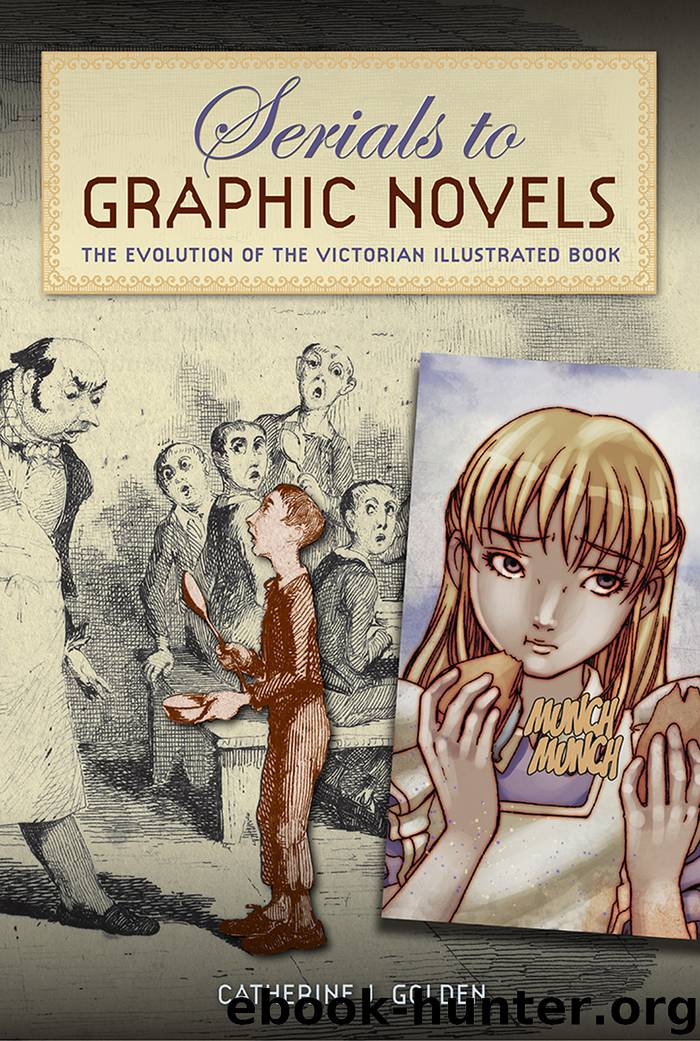Serials to Graphic Novels by Catherine J Golden

Author:Catherine J Golden [Golden, Catherine J]
Language: eng
Format: epub
ISBN: 9780813062297
Publisher: University Press of Florida
Published: 2018-02-15T05:00:00+00:00
Surveying Forms of Fin-de-Siècle Illustrated Fiction
Amidst changing aesthetic tastes and advances in technology, the Victorian illustrated book did not die out at the end of the century; it evolved. Illustration remained in certain serial formats, although the relationship between author and illustrator was far less intimate than in the 1830s and 1840s. Illustrated material gained new markets—principally, in small-circulation artists’ books, children’s literature on both sides of the Atlantic, and adult fiction in the US. Installment publication, the form that launched Dickens’s career, was still an easy, attractive way for a novice author to get published in England. For a publisher, parts publication was less of a financial risk than publishing in volumes and still guaranteed a writer a large middle-class readership. Stevenson published his debut novel serially in Young Folks in 1881; what we now know as Treasure Island first appeared under the title of The Sea Cook with one illustration. The work was popular, and it subsequently came out in book form in 1883 by an American publisher, Roberts Brothers of Boston, with four illustrations by Frank Merrill of Little Women fame.13 Hardy’s serial novels appeared with and without illustration, depending upon the journal in which he published. Macmillan’s Magazine, which did not publish fiction with illustrations, brought out The Woodlanders from 1886–87. Had Hardy published Tess of the d’Urbervilles serially in Macmillan’s, as he had hoped, it would not have been illustrated. Hardy published Tess in 1891 in a less prestigious periodical, The Graphic, which insisted on illustration as a publishing convention and censored portions of the novel deemed immoral for its middle-class readership.
Different from author and illustrator partnerships during the “Cruikshank-Phiz era” (Jackson 12), illustrators at the end of the nineteenth century commonly “received the completed manuscript of poetry, drama or fiction direct from the publisher,” notes Kooistra in The Artist as Critic, “and produced the illustrations with little or no connection to the writer, who was sometimes surprised by the final product” (3). This was common practice, one that Du Maurier laments in “The Illustrating of Books”: “What a fine thing it would be if author and artist could always meet in consultation over each separate design! But that seems impracticable” (2: 371). Whereas Dickens selected his book illustrators and worked with them in close collaboration, Hardy never met his principal Tess illustrator, Hubert von Herkomer, a Royal Academy painter. For serials published in The Graphic, it was not the serial’s author but the magazine staff who supervised the illustration process.14 There were four illustrators for Tess—Herkomer, E. Borough Johnson, Daniel A. Wehrschmidt, and J. Syddall. All four followed the representational school of illustration and produced illustrations with merit, although Wehrschmidt and Syddall have been considered “much inferior” to Johnson and Herkomer (Jackson 105). When fin-de-siècle illustrated serials appeared in book form, the illustrations were not typically included in the bound book, so readers today are often surprised to learn that Tess of the d’Urbervilles originally appeared in serial form with illustrations.
New markets arose for the illustrated book at the fin de siècle.
Download
This site does not store any files on its server. We only index and link to content provided by other sites. Please contact the content providers to delete copyright contents if any and email us, we'll remove relevant links or contents immediately.
| Ancient & Classical | Arthurian Romance |
| Beat Generation | Feminist |
| Gothic & Romantic | LGBT |
| Medieval | Modern |
| Modernism | Postmodernism |
| Renaissance | Shakespeare |
| Surrealism | Victorian |
4 3 2 1: A Novel by Paul Auster(11078)
The handmaid's tale by Margaret Atwood(6876)
Giovanni's Room by James Baldwin(5897)
Big Magic: Creative Living Beyond Fear by Elizabeth Gilbert(4737)
Asking the Right Questions: A Guide to Critical Thinking by M. Neil Browne & Stuart M. Keeley(4603)
On Writing A Memoir of the Craft by Stephen King(4224)
Ego Is the Enemy by Ryan Holiday(4005)
Ken Follett - World without end by Ken Follett(3984)
The Body: A Guide for Occupants by Bill Bryson(3822)
Bluets by Maggie Nelson(3726)
Adulting by Kelly Williams Brown(3683)
Guilty Pleasures by Laurell K Hamilton(3602)
Eat That Frog! by Brian Tracy(3529)
White Noise - A Novel by Don DeLillo(3444)
The Poetry of Pablo Neruda by Pablo Neruda(3375)
Alive: The Story of the Andes Survivors by Piers Paul Read(3323)
The Bookshop by Penelope Fitzgerald(3239)
The Book of Joy by Dalai Lama(3239)
Fingerprints of the Gods by Graham Hancock(3226)
